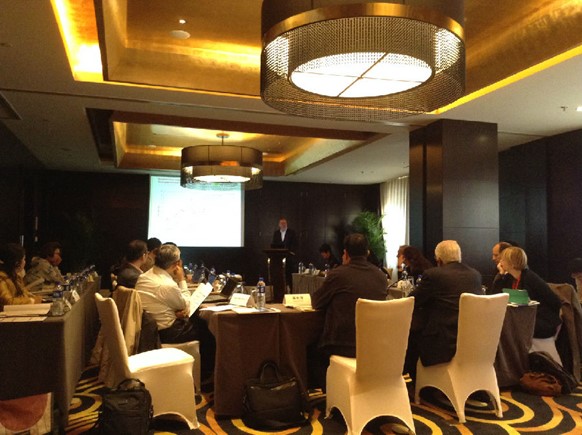CEMF October 11, 2016
On the afternoon of October 11, 2016, the US Environmental Denfense Funds (EDF) and the German Technical Cooperation Corporation (GIZ) jointly held a seminar on the theme of "Economic Analysis of Carbon Trading" in Beijing.
The meeting was chaired by Dr. Du Dande, vice president of EDF and academic member of CEMF. Dr. Du Dande pointed out that economic analysis can evaluate the impact of different carbon trading model designs, which is very important for optimizing carbon trading models and selecting carbon trading mechanisms. China is about to fully launch the carbon trading market in 2017. It is hoped that the discussion results of this theme seminar can provide a reference for the Chinese government to build a carbon trading market.
Dr. Felix Chr Matthes, research coordinator from the German Institute of Applied Ecology, first gave a speech on the topic of "Application of Models in Carbon Market Design: Case Study of EU Trading Market". Taking the empirical research of the European Union Emissions Trading System (EU ETS) as an example, he specifically introduced the design of various models in the carbon trading market, such as evaluating the effect of the EU ETS, cost effectiveness, industry coverage, the impact of EUETS, and predicting carbon prices. etc., and reviewed the effectiveness of economic model conclusions in the above fields. He pointed out that modeling can accumulate empirical data and help the EU ETS better design and select relevant policy tools, such as the choice of covered industries. By simulating different scenarios, the corresponding impact and emission reduction results can be seen more clearly , another example is the setting of emission thresholds, and the results of assessing transaction costs help decision makers to better choose policy tools. However, due to the volatility and lack of consistency of policies, there are often some differences between model predictions and actual effects.
Dr. Zhu Lei from Beihang University introduced the empirical research results of the research group of Beihang University on "the impact of carbon market design on regional economy and industry development". This study focuses on the strategic behavior of the emission trading market based on the performance of the carbon trading markets in seven pilot carbon trading provinces and cities. Dr. Zhu first analyzed the transaction costs and industry coverage of each pilot province and city, and pointed out that except for the relatively balanced Shenzhen market, the corporate emissions of each pilot province basically showed a "twenty-eight" distribution. Further data analysis showed that relative to transaction costs , marginal cost has a greater impact on the cost effectiveness of enterprises, which also shows that the setting of industry coverage for different provinces cannot be set across the board. Dr. Zhu further pointed out that the strategic behavior of companies has a significant impact on market performance. For quota buyers, such as steel and electric power companies, they tend to lower transaction prices; while for quota sellers, they tend to increase transaction prices; companies that accept prices often choose to reduce market transactions. The analysis of strategic behavior at the provincial level shows that with the expansion of industry coverage, the difference in emission reduction costs between regions decreases, and the marginal cost savings rate also decreases.
Researcher Jiang Kejun from the Energy Research Institute of the National Development and Reform Commission gave a speech titled "Low-Carbon Development and Energy Transformation". The speech was based on China's commitment to the 2-degree warming in the Paris Agreement, and predicted the changes in China's carbon emission curve under the background of reform. With the goal of 2°C warming, China should achieve the peak of carbon emissions in 2020-2030, and China's energy structure will undergo tremendous changes in the next five years. Dr. Jiang pointed out that low-carbon development will completely change the global technology competition pattern, and the future competition will be low-carbon, technology and intellectual property competition. my country should have a high awareness of low-carbon development, promote low-carbon development through economic means, and establish low-carbon advantages.
Jiang Zhaoli, deputy director of the Climate Department of the National Development and Reform Commission, summarized the meeting. He spoke highly of the theme seminar and believed that the carbon price influencing factors mentioned by the participating experts, the European ETS design and practical experience, and the empirical analysis conclusions of domestic pilot provinces and cities And suggestions for low-carbon development policies are of reference value for promoting the opening of the national carbon trading market in 2017. He pointed out that the experiences of Europe and North America have shown that accurate quantitative analysis can help better research and improve the institutional design of the carbon market, making it more open, fair, transparent and effective. Model research is the basis of our carbon market design. As a foundation and premise, the better the foundation of model analysis and quantitative analysis is, the more effective policy decisions will be. Director Jiang mentioned that the institutional arrangements for establishing databases and accumulating data would be strengthened in the future, and he also put forward specific research expectations for researchers.
 Seminar on "Economic Analysis of Carbon Trading"
Seminar on "Economic Analysis of Carbon Trading"

